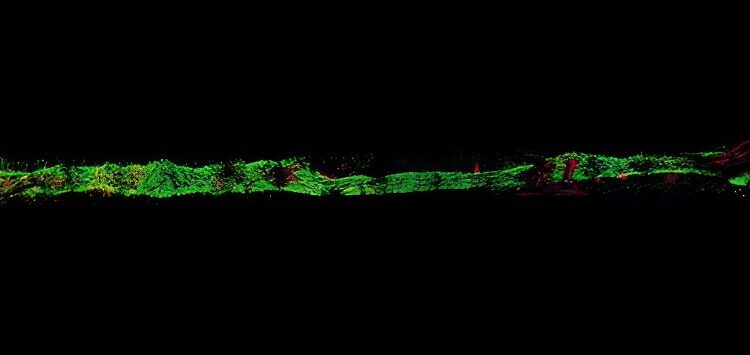Cedars-Sinai researchers used a unique 3D chip to examine the effects of chemotherapy on different types of heart cells. Credit: Sharma Lab at Cedars-Sinai
Chemotherapy can be toxic to heart cells. To help protect the hearts of cancer patients, Cedars-Sinai researchers created a three-dimensional “heart-on-a-chip” to evaluate drug safety. In a study published in the journal Lab on a chipthey show that the heart-on-a-chip, created from stem cells, accurately predicts the effects of drugs on human heart cells.
The investigators worked with induced pluripotent stem cells, which are blood cells reprogrammed into stem cells and can be transformed into any type of cell in the body. They used the stem cells to create two types of heart cells, but instead of placing them all together in an unstructured cell culture dish, as is usually done in heart toxicity tests, the investigators introduced the cells into specialized chips.
The 3D chips feature two channels arranged to intersect, keeping each cell type separate but allowing them to interact. The chips also allow movement and introduction of fluids.
“We cultured heart muscle cells and blood vessel cells,” said Arun Sharma, Ph.D., research scientist at the Board of Governors of the Institute for Regenerative Medicine, Smidt Heart Institute, Cedars-Sinai Cancer and the Cedars Department of Biomedical Sciences. -Sinai and lead author of the study.
“The chip allows us to stretch the cells back and forth to mimic a heartbeat and introduce fluid to mimic blood flow in the heart. It’s like giving the cells a workout that strengthens the muscle cells and allows vascular cells to form mini structures resembling blood vessels.
These “matured” cells provide a better testing platform for drug toxicity studies than cells that have not undergone this maturation process, because they more closely resemble the functioning of adult heart cells, Sharma said.
To demonstrate the competency of the heart-on-chip as a drug testing platform, the research team, including lead author and postdoctoral researcher Maedeh Mozneb, Ph.D., subjected the heart chip to a drug of chemotherapy called VEGFR/PDGFR. -inhibit tyrosine kinase inhibitor, known to have harmful effects on heart muscle cells and blood vessels. Damage was observed on both cell types in the heart chips.
If future studies continue to show good results, heart-on-a-chip technology could significantly reduce drug development costs and accelerate the availability of new therapies.
Another future possibility for these heart chips is the creation of patient-specific chips to personalize cancer treatment.
“If a cancer patient is receiving treatment that may have adverse effects on their heart, we can create induced pluripotent stem cells from a small sample of their blood,” Sharma said. “We can turn these stem cells into heart muscle and blood vessel cells and put them on a chip that will serve as a personalized avatar to indicate how that person’s heart might respond to treatment. This is one of the “most exciting applications of this technology”, truly advancing personalized medicine at Cedars-Sinai.
Another possibility is to expand these chips beyond a single organ.
“We hope to eventually bring our different organ models together,” said Clive Svendsen, Ph.D., executive director of the Board of Governors Regenerative Medicine Institute and co-author of the study. “My lab has refined this technology to help us develop neurological disease models, and other labs at our institute have been working on chips for the liver and gut microbiome. Bringing all of these chips together to create a ‘patient’ model-on-a-chip is part of our long-term vision for precision medicine. »
More information:
Maedeh Mozneb et al, A multi-lineage cardiac chip models drug cardiotoxicity and improves maturation of human stem cell-derived cardiovascular cells, Lab on a chip (2024). DOI: 10.1039/D3LC00745F
Provided by Cedars-Sinai Medical Center
Quote: “Heart on a chip” to test chemotherapies and other cancer drugs for cardiac toxicity (February 2, 2024) retrieved February 2, 2024 from
This document is subject to copyright. Except for fair use for private study or research purposes, no part may be reproduced without written permission. The content is provided for information only.



